Panther Martins, Rooster Tails, Blue Fox, Mepps
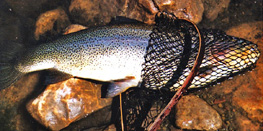
For nearly ten years I spent most of the time I fished using Mepps spinners exclusively. I caught salmon, steelhead, and trout in Utah, Idaho, Montana, Oregon, Washington, British Columbia, and Alaska. All I looked for was clear or green water in the streams I fished. My favorite spinner is still the Mepps, but I also like the panther martins, rooster tails, and blue foxes. I can easily feel the Mepps spinner spinning its way on the presentation. It makes a unique throbbing on my rod tip. I’m also partial to the white flash that comes from a genuine, silver-plated blade. This white flash is retained in low light and green water conditions. I’ve taken a 62 pound chinook salmon, an 18 pound coho, a 14 pound rainbow, a 17 pound steelhead, and an 8 pound brown trout using this spinner.
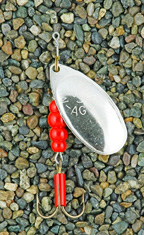
Panther martins, rooster tails and blue foxes are also usable. Panther martins seem to sink deeper than Mepps spinners. Their blade is a concave, convex blade that spins directly around the shaft because the shaft penetrates the blade. This blade is at a 40 degree angle. It spins quickly and evenly. It provides both vibration and flash. I like them when I want to fish deeply.
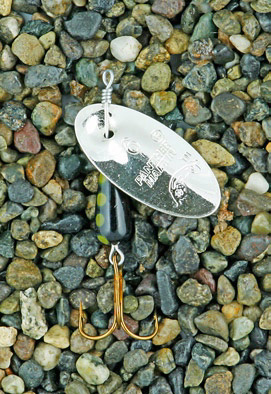
Rooster tails have heavy-weighted bodies and a blade that swings around the wire shaft held by a device. Also a built in squirrel tail is tied around the hook. The heavy body allows it to sink a little deeper than the Mepps. The blade seems to provide a subtle flash and vibration which is attractive to the fish.
Blue fox spinners are very similar to the Mepps spinners. The major difference is that the numbering system seems to differ. A size 4 Mepps feels to me like a 5 blue fox. Otherwise they fish about the same.
To sum up their uses, I prefer the Mepps for the most flash and vibration. I like the way the Panther Martin and Rooster Tail sink deep. Also their flash and vibration is more subtle than the Mepps.
I use spinners for streams and spoons for lakes. Although there are exceptions, the smaller spinners are more effective in lakes. The current helps work the spinner’s blade, providing a lot of flash while the lure is moving slowly.

Spinners are the go-to lure when fish are not busy feeding on insect hatch. At times of inactivity, spinners make things happen. They seem to wake things up by making the fish more aggressive.
My favorite finish on a spinner is real silver plate. Silver provides a white flash during low light conditions, while nickel or chrome plate looks tarnished in comparison. At low light, nickel and chrome can even appear black without a flash, or a dark brownish color. This fact puts lots of real silver plate in my spinner box.
Matching the lure to the prevailing conditions is important. The lure’s size and color must match the stream’s depth, flow rate, water temperature, water color, and light conditions.
I want my spinner to pass about one foot over the top of the fish. The stream’s depth and flow velocity determine which spinner size will be optimal. The smallest Mepps is #00 and weighs 1/8 oz. They progress up to some #5 that can weigh as much as 1 3/4 oz. Panther Martins come in 1/32, 1/16, 1/8, and 1/4 oz. sizes. Heavier Martins are available. So I select the spinner’s size and weight so that it will be one foot over the fish. Here the fish is constantly looking up at it. It is readily visible and easy for the fish to attack.
Water temperature is an important factor. Fish are cold-blooded creatures, which mean their body temperature is the same as the prevailing stream temperature. All fish have a preferred temperature range. At this ideal range fish are the most active.
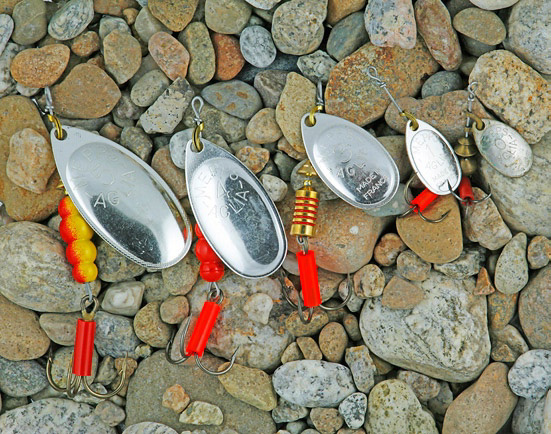
When the water temperature is colder than their preferred range, the fish are sluggish in their activities. Hence don’t expect them to chase spinners outside of
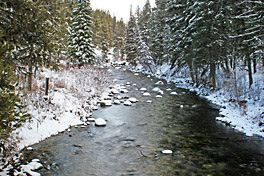
their comfort zone. Spin about one foot above their heads. Make the retrieve deliberate and slow. Allow it to cross paths with the fish. Use a 90° cross-stream retrieve that pulls the spinner a foot over the fish’s head and a foot or so out in front of him. It takes many more presentations to catch a fish in cold water than in ideal water temperatures.
Water clarity is important. Basically there are three colors: clear blue, green, and brown. Look at it this way, the fish must look through these colors just as if they were wearing sunglasses. Some colors will be more easily seen in green than in brown water, while too bright of a spinner in clear, blue water may be just too gaudy.
In clear, blue water, I prefer a darker colored spinner such as a black or metallic blue or green. Silver seems to always work.
In green water, my favorite finishes (other than silver which again is number one) are fluorescent pink,
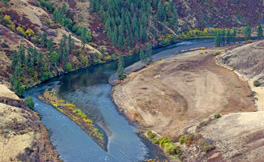
orange, red, and chartreuse. Combinations of these colors are also effective.
In stained, turbid water, I enjoy using gold, black, and again silver for its predictable hot, white flash. When the sky is dark, chartreuse is another favorite.
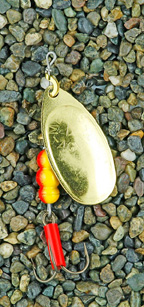
When the spawning run has started, I like finishes that match the fish’s spawn or spawning color. Fluorescent pinks, reds, and orange seem to draw the most strikes.
When the water temperature is in the ideal range for the fish species, you can entice fish to chase your spinner quite some distance from their home. You can quickly cover a lot of water and find and catch the most active fish. Again, one foot above the fish is best for the fish to be able to see your presentation, but the lure can be a ways upstream and still be
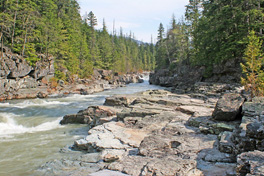
effective. You don’t have to put the lure a foot in front of him to attract a strike.
When the water temperature is too warm, it can become a problem. Again, you fish for inactive, sluggish fish by using the same presentations as in cold water. But at this temperature, expect the fish to migrate to the coolest areas such as where another stream, such as a cooler spring creek, enters the main stream. Or fish the head of a hole right up into the white water where it enters the deepest areas of the bigger holes. Look for fish that are schooled over spring holes. Once you have located these fish, expect some outstanding success.
Black is a favorite choice for a spinner in several different conditions. A sunny day and turbid brown water call for black color. Black retains its sharp silhouette and contrast. During bright sunshine on a warm day, black tones down the flash but retains the vibration attraction. Also, tarnished spinners are effective in producing a subtle flash. A tarnished brass or gold blade is another good choice. Finally, a black spinner contrasts well against a bright sky and is the best choice for night fishing. The silhouette is retained against the night sky which provides the only light available.
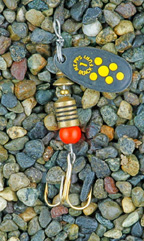
The retrieve of a spinner is an important factor in success. In larger streams, I like to cast across stream and a little upstream. The upstream portion allows time for the spinner to sink to my ideal one foot position overhead of the fish. I let the spinner drift and slowly spin and flash as it travels downstream. This provides a broadside view to the fish. This sideways view is the most visible and as the current causes the lure to swing away, it appears that it’s escaping. It’s at this swing that most strikes occur. My retrieve is just fast enough to put enough line tension to slowly swing the blade. My choice of spinner size is the one that will sink and suspend to this one foot above the fish level. Once the lure is directly downstream from you, drop the rod tip so the lure darts and flutters down. This may elicit a strike from a curious following fish.
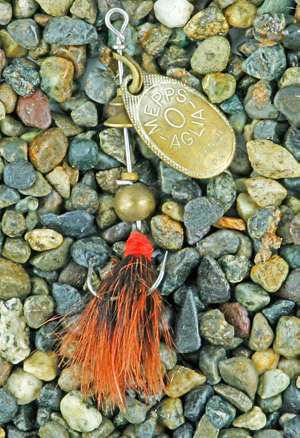
On occasion, I like to cast 3/4 or 7/8 upstream and retrieve the spinner downstream. The retrieve is just fast enough to keep the blade spinning one foot above the fish’s location. To the fish it looks like an injured bait fish is fleeing downstream. Since it’s traveling faster than the current, it elicits the striking impulse in the fish. The fish takes it before it gets away and the fish doesn’t have time to get a close look or to make up its mind. I have taken a lot of big brown trout using this method. I like to tone down the amount of flash so I use a tarnished brass blade. The fish quickly see and
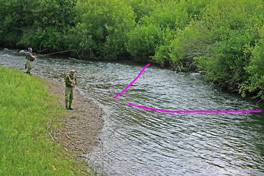
feel the vibration but they have difficulty seeing the lure clearly. Perhaps it mimics a darker bait fish like a sculpin. Parallel casts and retrieves to pocket water, prime lies, and undercut banks are effective.
I love spinners because I can quickly search a wide area for the most aggressive fish. These are the ones most willing to strike. Spinners help me locate fish, and if I miss, I can return to precisely fish their holding water. Plus the spinner seems to annoy lazy fish into activity. I love to spin fish a steelhead run and fish flies right after. Spinners wake up the fish and turn them into aggressive feeders. This works on other species of stream dwellers. Trout and smallmouth bass become aggressive after a spinner has awakened them from a lazy spell.
I try to suspend my spinners so that on my retrieve they travel the same depth. After the cast, I count down the sink rate and when it is a foot above the fish on the bottom, I start the retrieve and adjust the rate so my lure suspends at that depth.
A spinner invades the fish’s territory with its flash and vibration. This entices the fish to strike even when the bite gets tough. It appeals to the fish’s basic survival instincts.
Lure size is vital. The smaller spinners weigh less than the larger ones. A 00 Mepps weighs only 1/8 oz., while a size 5 weighs about 3/4 oz. Some models can
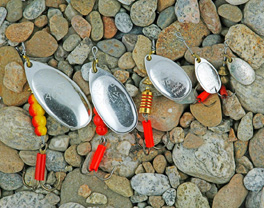
weigh as much as 1 3/4 oz. Again I choose the weight that’s optimal to suspend it a foot above the fish’s location. I’ll use a small spinner on fish holding in shallow, slow-moving water, while I prefer a larger, heavier spinner for fish holding in a fast, deep run. Also the amount of flash depends upon lure size. The larger spinner has more flash than a small one. When I need a heavy spinner in clear water, sometimes that silver blade has too much flash and puts the fish down. That’s when color is important. A dull or darker blade may be effective. But first you must reach the level that the fish are holding. Next the amount of flash and/or color to get the fish is vital. Compensate by using the optimal amount of flash and/or color to get the fish to bite.
Water temperature affects how fast you fish the spinner. In water that is too cold for the fish to be active, you must slow things down. A slower retrieve and a presentation that puts the lure directly over the fish are called for. This means lots of casts and slow retrieves over every likely holding lie. But when temperatures are ideal and the fish are active, you can cover more water quickly. Space the casts farther apart because the fish will actively move to the spinner. You can speed up the retrieve and cover lots of water.
The two most favored knots are the improved clinch and the BC knot. Tie your line directly onto the

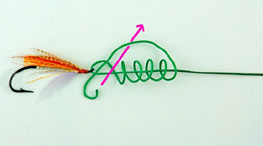
spinner shaft’s eye. You don’t need a swivel. Good spinners don’t twist the line unless you’re retrieving way too fast.
Early season tactics call for taking the spinner directly to where the fish are holding. Fish the slow moving water, log structures, boulders, and places which provide cover from the current. The seam where a rapid enters a slow, deep pool is a good spot. Use copper and brass in off-colored water, but in clear water use rainbows and silver colors. But remember, silver works well in all conditions. Just vary the silver spinner’s size to reach the fish’s lies.
Summer tactics are different. Fish move into deep holes at the foot of oxygenated white water. Explore all the possible holding lies. Active fish will travel a good distance to chase a spinner. A summer rainstorm brings subdued lighting and active fish. They will really come out for the food. After a heavy rain, fish gorge themselves on the increased supply of food washed into the stream.
A good idea is to fish a stream’s popular holes at different places than their beaten paths lead to. Wade away from the worn spots and give the fish a different presentation. This fresh angle can reward you with fish that would refuse the same old presentation.
I am rarely successful when reeling a spinner directly upstream, while a downstream retrieve is far more successful. Most fish prefer the tumbling-acrossstream presentation with a swing away.
Spinners work well or all types of fish species. Walleyes love a copper Mepps--perhaps it shines like a night crawler. Panfish love the small sizes. I’ve taken most of my white bass on a 0 or 1 silver Mepps.
The physics of light as it travels through water is important. The rainbow colors of red, orange, yellow, green, blue, indigo and violet are filtered out in this same order. That means in low light the reds, orange, and yellows are difficult to see while the blue, indigo, and violets retain their colors. But silver doesn’t change. Select the colors of the spinners for the light intensity.
Over the years I’ve caught nearly every species on a spinner. It is the go-to lure when fish are not on the food. It’s also a great locator to find where the fish are

holding. I’ve had success in still waters, but it seems that my retrieve has to be faster than I’d like it. I usually fish spoons in still waters and spinners in moving waters, although the smaller spinners are great in still water because they spin at slower retrieve rates.
For years I carried a box of Mepps spinners in size 1, 2, 3, and 4. Most of them were silver and the remainder was brass. With these I caught fish consistently everywhere. My first steelhead took a size 4 Mepps and I will always remember its leaping battle.

© 2025 The Gale Group, Inc. All rights reserved.
© 2025 Perigee Learning LLC. All rights reserved.
LoveTheOutdoors.com is owned and operated by Advameg, Inc. © 2025 Advameg, Inc.
Camping Adventures • Dutch Oven Cooking • Sports Knots
Fly Tying • Freshwater Fishing • Fly Fishing

